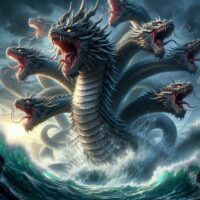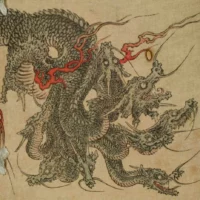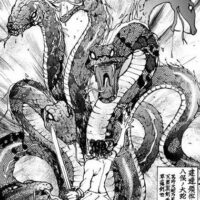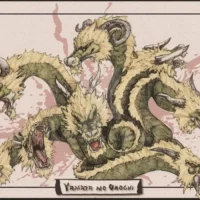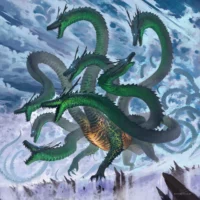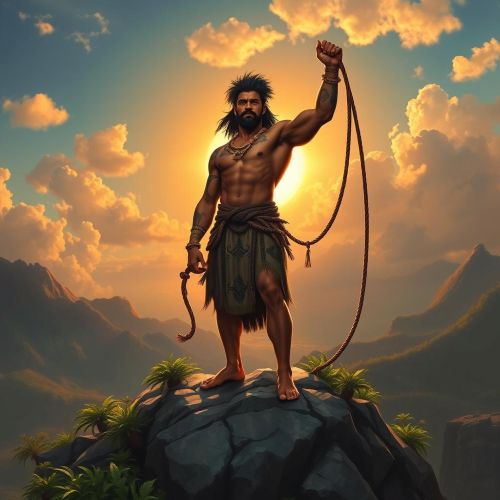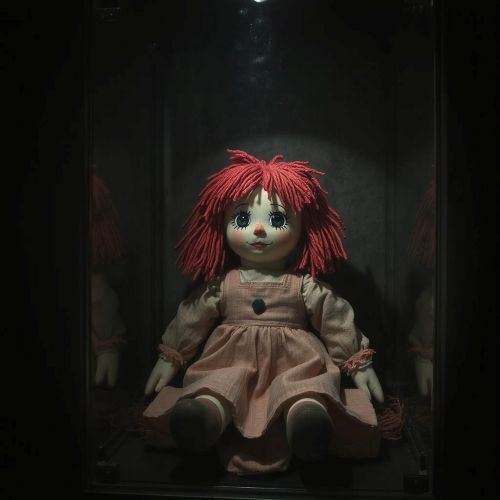Yamata no Orochi : The Massive Serpent
Listen
At a glance
| Description | |
|---|---|
| Origin | Japanese Mythology |
| Classification | Animals |
| Family Members | N/A |
| Region | Japan |
| Associated With | Size, Strength |
Yamata no Orochi
Introduction
Yamata no Orochi, a legendary serpent embodying chaos and destruction, is a prominent figure in Japanese mythology. Its tale, featuring the storm god Susano’o’s triumph over evil, underscores the themes of bravery and resourcefulness. Few creatures in Japanese folklore match Orochi’s imposing presence and significance. Its eight heads and tails are emblematic of its power and menace, captivating generations with its mystique. From its origins in ancient tales to its central role in cultural narratives, Orochi remains a formidable symbol within Japanese lore.
Physical Traits
Yamata no Orochi’s depiction is truly terrifying, as described in both the Kojiki and Nihongi, ancient Japanese texts. This monstrous serpent is adorned with eight heads and eight tails, its eyes burning like winter cherries. Spanning across eight valleys and hills, its presence leaves a trail of destruction. Additionally, the texts vividly portray the grotesque flora growing on its back, representing the desolation it brings. With bright red eyes and a crimson belly, Yamata no Orochi’s colossal form strikes fear into observers. Its heads, adorned with piercing eyes, exude an ominous allure as its massive body twists with a menacing grace. Legends further embellish its formidable nature, attributing scales as impenetrable as iron. Despite its monstrous visage, Yamata no Orochi captivates with a blend of fear and fascination.
Family
Yamata no Orochi’s origins are shrouded in mystery, with various accounts presenting differing narratives. One well-known tale involves its association with the storm god, Susanoo. In this legend, Susanoo encounters a family in distress, as their daughter faces sacrifice to the serpent. Motivated by compassion, Susanoo devises a plan to defeat Yamata no Orochi and rescue the girl. Through his wit and valor, Susanoo succeeds in slaying the serpent, liberating the land from its tyranny and earning the enduring gratitude of its inhabitants. However, traditional mythology doesn’t mention Yamata no Orochi having a family; it typically portrays it as a solitary entity driven by primal instincts of hunger and destruction. While some interpretations suggest it may serve a malevolent deity, these accounts lack widespread acceptance. In the myth, Susanoo encounters two Earthly Deities near the headwaters of the Hi River (now the Hii River) in Izumo Province, who had been sacrificing their daughters to Yamata no Orochi. Susanoo intervenes by transforming their eighth daughter, Kushi-inada-hime, into a comb for safekeeping.
Other names
Throughout history, the legendary serpent Yamata no Orochi has been known by various names, each reflecting different facets of its character and legacy. Some accounts simply refer to it as Orochi, emphasizing its status as a fearsome serpent of unparalleled strength. Others recognize it as Yamata no Orochi, highlighting its connection to the ancient Japanese region of Izumo, where many of its most famous legends originate. Regardless of the name used, Yamata no Orochi remains a potent symbol of power and peril in Japanese mythology. Its most common name translates literally to “eight-forked-great-snake,” but it has been recorded under various aliases such as Orochi, Yamata no Orochi no Magami, and Yamata Oroechi. These names capture different aspects of its mythic persona, from its awe-inspiring strength to its divine status.
Powers and Abilities
Yamata no Orochi commands a range of formidable powers and abilities befitting its legendary stature. Its mastery over the elements is renowned, capable of summoning storms and unleashing torrents of water upon adversaries. In combat, the serpent’s eight heads strike with deadly precision, instilling fear in all who dare to confront it. Tales even speak of its remarkable ability to regenerate heads and tails, rendering it nearly invincible. However, despite its immense strength, Yamata no Orochi harbors vulnerabilities, often requiring adversaries to rely on cunning and strategy for victory. Its sheer physical prowess allows it to level mountains and obliterate anything in its path, while its multiple heads enable simultaneous attacks from various angles, sowing confusion among enemies. Though legends are silent on any magical abilities, the serpent’s imposing size and ferocity make it a formidable opponent in Japanese mythology.
The most famous story involving Yamata no Orochi features the storm god Susano’o. Exiled from heaven, Susano’o arrives in the land of Izumo where he encounters an elderly couple weeping. They explain their plight: their eight daughters were offered as sacrifices to Yamata no Orochi, and now only their youngest, Kushinada-hime, remains.
Susano’o proposes a plan. He instructs the couple to build eight barrels of strong sake and place them around their house. When Yamata no Orochi arrives, intoxicated by the sake, Susano’o emerges and attacks the eight drunken heads, slaying them all. From the serpent’s tail, Susano’o discovers the legendary Kusanagi sword, a weapon imbued with powerful magic.
This story highlights several key aspects of Japanese mythology. Susano’o, a complex deity representing storms and the sea, embodies both destructive and protective forces. His resourcefulness and cunning are key to overcoming the overwhelming power of Yamata no Orochi. The sake, a staple in Japanese culture, becomes a symbol of both hospitality and a clever trap. Finally, the Kusanagi sword becomes a treasured weapon, passed down through generations of heroes.
Modern Day Influence
Though millennia have passed since ancient Japan, the enduring legacy of Yamata no Orochi persists in the modern world. Its tale has been retold across literature, art, and popular culture, sparking wonder and fascination globally. From video games to manga, Yamata no Orochi’s influence permeates various mediums, each interpretation enriching its timeless narrative. Its profound impact transcends entertainment, resonating deeply with audiences who remain enthralled by its myth, ensuring that Yamata no Orochi’s legend remains etched in memory. This captivating entity continues to thrive in contemporary culture, featuring prominently in video games, anime, and manga as a formidable antagonist or a symbol of formidable challenges overcome. Moreover, its iconic imagery extends to advertising and merchandise, embodying both fear and the triumph of overcoming adversity.
Furthermore, the cultural significance of the Yamata no Orochi legend endures. In Matsue, Shimane Prefecture, an annual festival commemorates Susano’o’s triumphant victory. The festival showcases elaborate dragon boats symbolizing the serpent’s eight heads racing down the river, showcasing vibrant local traditions. Beyond entertainment, Yamata no Orochi’s mythological significance permeates various aspects of modern life, cementing its place as a cherished cultural symbol. Its presence extends to cinema, as evidenced by its appearances in Toho films and its namesake for a Titan in Legendary Pictures’ Monsterverse, further solidifying its enduring impact on contemporary culture.
Related Images
Frequently Asked Questions
What is lorem Ipsum?
I am text block. Click edit button to change this text. Lorem ipsum dolor sit amet, consectetur adipiscing elit. Ut elit tellus, luctus nec ullamcorper mattis, pulvinar dapibus leo.
What is lorem Ipsum?
I am text block. Click edit button to change this text. Lorem ipsum dolor sit amet, consectetur adipiscing elit. Ut elit tellus, luctus nec ullamcorper mattis, pulvinar dapibus leo.
What is lorem Ipsum?
I am text block. Click edit button to change this text. Lorem ipsum dolor sit amet, consectetur adipiscing elit. Ut elit tellus, luctus nec ullamcorper mattis, pulvinar dapibus leo.
What is lorem Ipsum?
I am text block. Click edit button to change this text. Lorem ipsum dolor sit amet, consectetur adipiscing elit. Ut elit tellus, luctus nec ullamcorper mattis, pulvinar dapibus leo.
What is lorem Ipsum?
I am text block. Click edit button to change this text. Lorem ipsum dolor sit amet, consectetur adipiscing elit. Ut elit tellus, luctus nec ullamcorper mattis, pulvinar dapibus leo.

